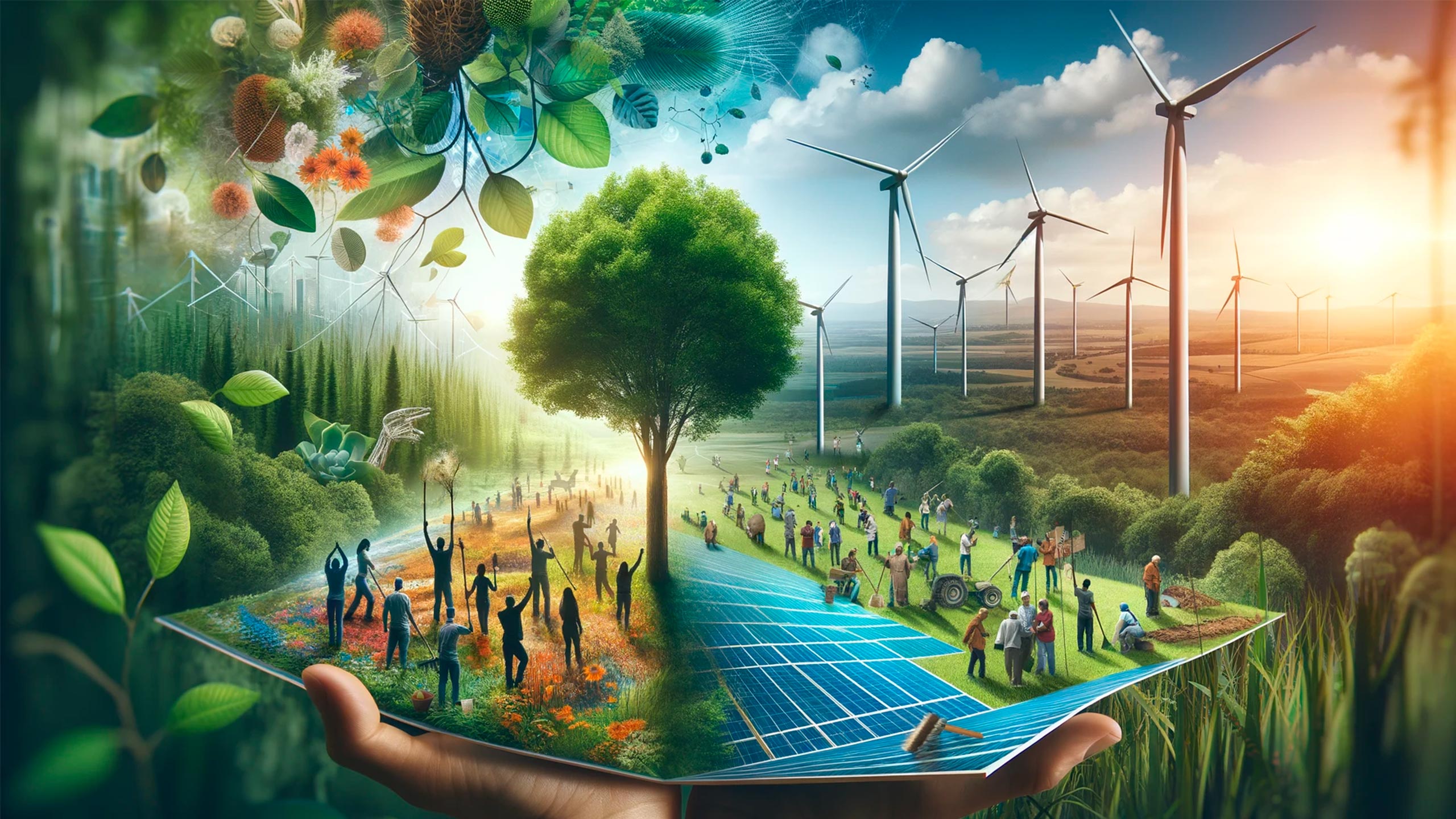Introduction to Sustainable Development
Sustainable Development is more than just an environmental initiative; it is a comprehensive approach that aims to harmonize human progress with the planet’s health. This keyphrase represents a multifaceted goal: to provide for the needs of the current generation without sacrificing the prospects of future generations. It is about fostering an economy that thrives while ensuring social justice and preserving the natural environment upon which all life depends.
In practice, sustainable development requires a balance between these three critical aspects:
- Economic Growth: Developing robust economies that can sustain populations without depleting natural resources.
- Social Inclusion: Ensuring that all individuals have access to basic necessities and are included in societal advancements.
- Environmental Protection: Safeguarding ecosystems and biodiversity to maintain the natural cycles that support life on Earth.
The significance of Sustainable Development in our contemporary world cannot be overstated. As we face global challenges like climate change, resource depletion, and social inequities, this concept becomes a beacon of hope—a blueprint for a future where development is both resilient and respectful of the Earth’s limits. Embracing this approach is not only imperative for our survival but also for the thriving of countless species that share our world.
Historical Context of Sustainable Development
The concept of Sustainable Development has undergone a profound evolution, from a nascent idea to a principle that underpins global initiatives. This keyphrase first gained prominence in the 1970s when the United Nations Conference on the Human Environment put the spotlight on the interdependence of conservation and development.
In the decades that followed, the Brundtland Commission in 1987 provided a pivotal moment by defining sustainable development explicitly and bringing it into the policy mainstream. This was a turning point that linked the concept to the urgent need for environmental protection in the face of rapid industrialization.
The 1992 Earth Summit in Rio marked another critical juncture, leading to the establishment of Agenda 21—a comprehensive plan of action to foster sustainable development globally. In the new millennium, the Millennium Development Goals and later the Sustainable Development Goals in 2015 have further cemented this concept as a universal call to action.
Throughout its history, Sustainable Development has expanded in scope to include not just environmental sustainability, but also equitable economic development and social inclusion. The timeline reflects humanity’s increasing acknowledgment of our planet’s limitations and the need for a harmonious coexistence with nature.
The Three Pillars of Sustainable Development
Sustainable Development is built upon three foundational pillars—each crucial for achieving a balanced and inclusive global society. These pillars are social, economic, and environmental sustainability, and they encompass the comprehensive scope of sustainability.
- Social Sustainability: This pillar focuses on maintaining social well-being and equity. It emphasizes the importance of universal human rights, access to essential services, and the creation of a just and inclusive society. Social sustainability advocates for education, healthcare, and equality to ensure that every individual has the opportunity to contribute to and benefit from development.
- Economic Sustainability: Economic sustainability seeks to generate prosperity while ensuring equity and resilience. It involves building economies that provide opportunities for all, without compromising the natural resources and ecosystems. Economic policies must be designed to promote long-term growth and prevent cycles of boom and bust that can lead to economic downfall.
- Environmental Sustainability: The environmental aspect is about protecting the Earth’s natural systems, preserving biodiversity, and mitigating the effects of climate change. It’s about living within the planet’s ecological limits and ensuring that our natural environment can continue to support life.
Together, these pillars provide a holistic framework for Sustainable Development—one that guides policies and practices towards a future where economic growth, social inclusion, and environmental health are in harmony.
The Global Goals: United Nations’ Sustainable Development Goals (SDGs)
The Sustainable Development Goals (SDGs), established by the United Nations in 2015, are a universal call to action to end poverty, protect the planet, and ensure that all people enjoy peace and prosperity by 2030. These 17 goals form a blueprint for dignity, equality, and well-being on a healthy planet. Here is an outline of the SDGs:
- No Poverty: Eradicate poverty in all its forms everywhere.
- Zero Hunger: End hunger, achieve food security and improved nutrition, and promote sustainable agriculture.
- Good Health and Well-being: Ensure healthy lives and promote well-being for all at all ages.
- Quality Education: Ensure inclusive and equitable quality education and promote lifelong learning opportunities for all.
- Gender Equality: Achieve gender equality and empower all women and girls.
- Clean Water and Sanitation: Ensure availability and sustainable management of water and sanitation for all.
- Affordable and Clean Energy: Ensure access to affordable, reliable, sustainable, and modern energy for all.
- Decent Work and Economic Growth: Promote sustained, inclusive, and sustainable economic growth, full and productive employment, and decent work for all.
- Industry, Innovation, and Infrastructure: Build resilient infrastructure, promote inclusive and sustainable industrialization, and foster innovation.
- Reduced Inequality: Reduce inequality within and among countries.
- Sustainable Cities and Communities: Make cities and human settlements inclusive, safe, resilient, and sustainable.
- Responsible Consumption and Production: Ensure sustainable consumption and production patterns.
- Climate Action: Take urgent action to combat climate change and its impacts.
- Life Below Water: Conserve and sustainably use the oceans, seas, and marine resources for sustainable development.
- Life on Land: Protect, restore, and promote sustainable use of terrestrial ecosystems, manage forests sustainably, combat desertification, and halt and reverse land degradation and halt biodiversity loss.
- Peace, Justice, and Strong Institutions: Promote peaceful and inclusive societies for sustainable development, provide access to justice for all, and build effective, accountable, and inclusive institutions at all levels.
- Partnerships for the Goals: Strengthen the means of implementation and revitalize the global partnership for sustainable development.
Each goal addresses a specific area of sustainable development, recognizing that ending poverty must go hand-in-hand with strategies that build economic growth and address a range of social needs, including education, health, social protection, and job opportunities, while tackling climate change and environmental protection.
Case Studies of Progress: Examples of Sustainability in Practice
Around the world, numerous initiatives showcase how sustainable practices are successfully implemented. These case studies highlight the practical application and impact of environmental, economic, and social strategies.
- Reforestation in Costa Rica: This Central American nation has doubled its forest cover in the last 30 years while growing its economy, demonstrating how conservation efforts can coexist with economic development. Learn more about Costa Rica’s reforestation
- Bhutan’s Gross National Happiness: Bhutan measures prosperity through the holistic balance of economic success and the emotional, psychological, and cultural well-being of its citizens. Discover Bhutan’s unique approach
- Denmark’s Wind Energy: Leading the way in renewable energy, Denmark is on track to be free of fossil fuels by 2050, with wind turbines already generating more than 40% of its electricity. Explore Denmark’s wind energy success
- Sustainable Agriculture in Kenya: Small-scale farmers in Kenya are using mobile technology to access weather data and sustainable farming practices, leading to increased crop yields and reduced environmental impact. Read about Kenya’s agricultural advancements
These stories prove that sustainable initiatives can flourish, providing tangible benefits while protecting our planet. They serve as inspiring models for others to replicate and adapt according to their unique contexts and needs.
Overcoming Obstacles in the Pursuit of Global Goals
While the ambition of the SDGs is laudable, the path to achieving them is fraught with challenges and critiques. One significant obstacle is the vast inequality between and within countries that can skew the allocation of resources and attention. Another critique is that the broad scope of the SDGs can lead to conflicting priorities, where progress in one area may inadvertently lead to setbacks in another.
Critics also point out the difficulty in measuring progress due to the complexity of the goals and the variety of indicators. Additionally, there is a concern that the private sector may not always align with sustainable development principles, prioritizing profit over the long-term welfare of communities and the environment.
Despite these challenges, the SDGs serve as a critical framework for international cooperation and a unified direction for global development efforts. Addressing these critiques head-on is essential for forging a path to a more equitable and sustainable future.
Frequently Asked Questions: Insights on Global Sustainability Efforts
Q: What are the most pressing challenges in achieving the SDGs?
A: The primary challenges include resource allocation, managing inter-sectoral trade-offs, and ensuring inclusive participation from all sectors of society. It’s crucial to balance immediate needs with long-term sustainability goals.
Q: Can sustainable practices coexist with economic growth?
A: Yes, they can. Economic growth and sustainability are not mutually exclusive. Sustainable economic models seek to foster growth while preserving natural resources for future generations.
Q: How can individuals contribute to the SDGs?
A: Individuals can contribute by adopting sustainable lifestyles, supporting responsible businesses, and advocating for policies that promote sustainability. Every action, no matter how small, contributes to the collective effort.
Q: What role do businesses play in sustainable development?
A: Businesses are key players in sustainable development. By adopting sustainable practices and green technologies, they can reduce their environmental impact and drive innovation in sustainability.
Toward a Greener Tomorrow: Steps for Collective Action
In conclusion, the journey toward a more sustainable world is not just a responsibility but a necessity. We’ve explored the meaning and evolution of sustainable practices, the significance of the UN’s SDGs, and real-world applications that demonstrate the feasibility of these goals. It is clear that a combined effort from individuals, businesses, and governments is essential to make sustainable living a reality. We all have a role to play in this collective endeavor, and it starts with making conscious decisions that align with the principles of sustainability. Let’s work together for a greener, more equitable future.



